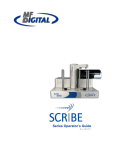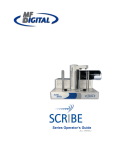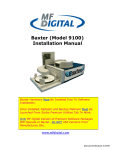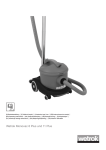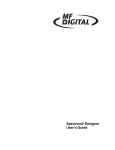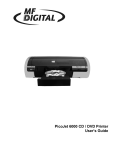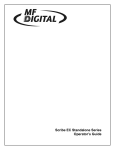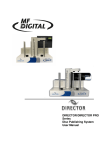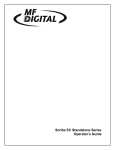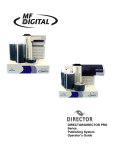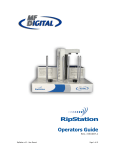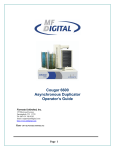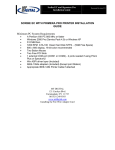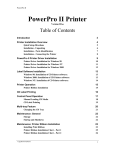Download SCRIBE PC User`s Manual Rev.:103105
Transcript
Series Operator’s Guide Rev.: 102005.1 Rev. 103105.1 Copyright Notice Copyright ©2005 by MF DIGITAL. All rights reserved. This manual and the accompanying illustrations may not be copied, reproduced, electronically transmitted, or translated into another language, in whole, or in part, without the written consent of MF DIGITAL MF DIGITAL, SCRIBE-PC, SCRIBE-SA, Baxter, Director, and 5906-Live are trademarks of MF DIGITAL Other trademarks referred to are the property of their respective trademark or registered trademark holders. Warranty MF DIGITAL warrants to the original purchaser that the equipment that you have purchased is free from defects in materials and workmanship, for a period of time as follows: Duplicator Electronics & Mechanical Parts Recorders (warranty by drive manufacturer) Prism Plus Thermal Printer PicoJet Inkjet CD/DVD Printer 1 year 1 year 6 Months 1 year limited warranty This warranty is applicable when the warranty registration has been completed and returned to MF DIGITAL within a reasonable period of time following the purchase and the warranty is NOT transferable. This warranty does not apply to malfunctions caused by misuse, negligence, accident, or alteration, nor is MF DIGITAL responsible for consequential damages related to the use of this equipment. This warranty is made in lieu of any other warranty expressed or implied. Recorder Warranty Policy Individual recorders manufacturers are responsible for the products they produce. As a convenience, MF DIGITAL will honor any service issue related to a defective recorder or printer while under its respective manufacturer’s warranty providing that the recorder has been purchased from MF DIGITAL either directly or indirectly. MF DIGITAL has no responsibility for products NOT purchased through MF DIGITAL Piracy The copying of audio, video, or software without the permission of the copyright holder is illegal. MF DIGITAL accepts no responsibility for the copyright use or misuse of this equipment. It is the sole responsibility of the user to ensure that the legal rights of copyright in duplicating and printing are respected. MF DIGITAL 121 Carolyn Blvd. Farmingdale, NY 11735 Tel.: (001) 631 249 9393 Fax.: (001) 631 249 9273 Email: [email protected] http://www.mfdigital.com Page 1 Rev. 103105.1 Table of Contents ABOUT MF DIGITAL .............................................................................................................................................. 4 WHAT TO EXPECT FROM YOUR MF DIGITAL CD DUPLICATION SYSTEM.............................................................. 4 ABOUT THIS MANUAL .......................................................................................................................................... 4 INSTALLING THE SCRIBEPC .............................................................................................................................. 5 WHAT’S IN THE BOX ................................................................................................................................................. 5 WHAT YOU WILL ALSO NEED: .................................................................................................................................... 5 OPTIONS .................................................................................................................................................................... 5 PACKING MATERIALS ................................................................................................................................................ 6 THE BEST PLACE TO PUT THE SCRIBEPC.................................................................................................................. 6 SAFETY PRECAUTIONS............................................................................................................................................... 6 REMOVING PACKING RESTRAINTS............................................................................................................................. 7 INPUT AND OUTPUT SPINDLES .................................................................................................................................. 7 MAKING THE CONNECTION ........................................................................................................................................ 7 STARTING UP ............................................................................................................................................................ 8 INSTALLING THE SCRIBEPC SOFTWARE....................................................................................................... 9 QUICK START, MAKING COPIES ..................................................................................................................... 13 STARTING THE SCRIBEPC APPLICATION ................................................................................................................. 13 THE SCRIBEPC APPLICATION.......................................................................................................................... 16 STARTING THE SCRIBEPC APPLICATION ................................................................................................................. 16 SCRIBEPC APPLICATION LAYOUT ........................................................................................................................... 18 Reviewing and changing the settings.................................................................................................................. 18 Settings Editor .................................................................................................................................................... 19 Application Temp Folder.................................................................................................................................... 20 CD / DVD IMAGES DEFAULT FOLDER .................................................................................................................... 20 CD LABELS DEFAULT FOLDER ................................................................................................................................ 20 SPINDLE SELECT ...................................................................................................................................................... 20 PRINTER DRIVER ..................................................................................................................................................... 21 DATA IMAGE EDITOR ......................................................................................................................................... 22 CREATING A DATA DISC IMAGE ................................................................................................................................ 22 IMAGE TOOLBAR ..................................................................................................................................................... 23 SELECTING CD CAPACITY ....................................................................................................................................... 24 ADDING FILES AND FOLDERS .................................................................................................................................. 24 CREATING, RENAMING, AND REMOVING FOLDERS .................................................................................................. 24 STATIC AND DYNAMIC CONTENT ............................................................................................................................ 25 SAVING THE CURRENT DISC IMAGE FILE ................................................................................................................ 26 Editing Image properties .................................................................................................................................... 26 To create a physical disc image file: .................................................................................................................. 28 LOADING AN EXISTING SCRIPT FILE ....................................................................................................................... 28 AUDIO IMAGE EDITOR ....................................................................................................................................... 30 AUDIO IMAGE EDITOR TOOLBAR ............................................................................................................................. 31 ADDING TRACKS ..................................................................................................................................................... 32 Page 2 Rev. 103105.1 REMOVING TRACKS................................................................................................................................................. 32 CHANGING A UPC CODE ........................................................................................................................................ 33 CHANGING ISRC CODES AND COPY PROHIBIT FLAGS ............................................................................................ 33 INSERTING, EDITING AND REMOVING SILENCE ....................................................................................................... 35 INSERTING, EDITING AND REMOVING SUBINDEXES ................................................................................................ 36 SAVING THE CURRENT AUDIO DISC IMAGE ............................................................................................................ 37 To create a physical audio disc image file (.IMG):............................................................................................ 37 LOADING AN EXISTING SCRIPT FILE ....................................................................................................................... 38 JOB MANAGER TAB ............................................................................................................................................. 39 THE PRODUCTION PROCESS ..................................................................................................................................... 40 CREATING A JOB ...................................................................................................................................................... 40 ARCHIVE ONLY – READING IN A MASTER DISC ......................................................................................................... 42 COPY AND / OR VERIFY ........................................................................................................................................... 44 RELAY MODE JOB .................................................................................................................................................... 46 PRINT ONLY JOB ...................................................................................................................................................... 48 NETWORK CLIENT SOFTWARE....................................................................................................................... 50 CLIENT PC MINIMUM REQUIREMENTS: .................................................................................................................... 50 INSTALLING THE CLIENT SOFTWARE ........................................................................................................................ 50 USING THE CLIENT SOFTWARE ................................................................................................................................. 51 APPENDIX A: CREATING .PRN FILES (PRISM PLUS) ................................................................................. 52 PRINTER DRIVER SETUP ........................................................................................................................................... 52 MAKING A .PRN LABEL FILE ................................................................................................................................... 52 APPENDIX B: CREATING .PRN FILES (PICOJET) ........................................................................................ 54 PRINTER DRIVER SETUP ........................................................................................................................................... 54 MAKING A .PRN LABEL FILE ................................................................................................................................... 55 APPENDIX C: PREMIUM UTILITIES................................................................................................................ 58 RIPTASTIC FOR MF DIGITAL.................................................................................................................................... 58 BACK-UP PLATINUM FOR MF DIGITAL .................................................................................................................... 59 ORDERING PREMIUM UTILITIES ............................................................................................................................... 59 INSTALLING ADD-ON APPLICATIONS ........................................................................................................................ 59 BECOMING AN ADD-ON DEVELOPER. ....................................................................................................................... 59 APPENDIX D: SCRIBEPC ALIGNMENT UTILITY ......................................................................................... 60 Page 3 Rev. 103105.1 About MF DIGITAL Thank you for purchasing MF DIGITAL’s ScribePC autoloading duplication and printing system. MF DIGITAL manufactures a wide variety of software and audio duplication and production equipment, including manual and fully automatic CD and DVD duplicators and printers. We hope you will consider us for all of your production needs. What To Expect From Your MF DIGITAL CD Duplication System Your MF DIGITAL ScribePC duplication system is professionally designed and manufactured to give you years of trouble free operation. To avoid accidental damage to your new duplication system, please read and understand this manual thoroughly before operating the unit. About This Manual This manual is written for both novice and experienced users. Please read through this Operator’s Guide from beginning to end before using the unit. Once having read the manual, follow along chapter by chapter. This will provide the necessary understanding of your new ScribePC duplication system. Page 4 Rev. 103105.1 Installing The ScribePC Carefully remove the ScribePC duplication system from the shipping container. Inspect the contents and verify them against the packing slip. Report any errors in shipping as soon as possible. The ScribePC is available as a copy only system, or both a copy and print system. What’s In The Box Your ScribePC CD / DVD duplication system has a PC onboard, so there is no need to buy or dedicate a PC to operate it. The package includes: • ScribePC duplication system • Power cord • ScribePC Software / Manual CD What you will also need: • PC compatible VGA Monitor (if LCD, use an analog one) • PC Mouse (P/S2 Style recommended) • PC Keyboard (P/S2 Style recommended) Options • CD label printers: Supported models include the MF Digital PicoJet Inkjet Printer, and Prism Plus Thermal Printer. • MP3 / WMA audio CD batch ripping software • Hard disk back-up software • 80mm and BizCDs autoloader and printer adapters. Page 5 Rev. 103105.1 Packing Materials Please retain the original box and packaging in the event that the unit requires future servicing. This will help to reduce the possibility of damage occurring in transit. In the event that the system is shipped back to MF DIGITAL without the original box and packaging, customers will be charged for new box and packaging. The Best Place To Put The ScribePC The best operating location for the ScribePC duplication system is in a climate controlled area, free of dirt, dust, humidity, excessive heat, and electronic or electromagnetic interference. Room temperature should be between 65 and 75 degrees Fahrenheit, or between 18 and 23 degrees Celsius. Place the ScribePC on a solid, steady work surface and allow sufficient room for all incidental work materials. Provide at least six inches of clearance on all sides of the unit for ventilation. Safety Precautions The system is shipped with a three-prong power connector and must be used with a properly grounded AC receptacle. DO NOT try to defeat the third “ground” prong. All computer peripherals must be properly grounded and the ScribePC is no exception. The use of a power conditioner such as an Uninterruptible Power Supply (UPS), or a surge protector is highly recommended. The minimum required size is 400VA. Repairs or alterations should only be attempted by authorized factory trained technicians. MF DIGITAL reserves the right to void the warranty if unauthorized service is performed. Page 6 Rev. 103105.1 Removing Packing Restraints The ScribePC ships with a picker arm restraint to reduce the possibility of damage in transit. This restraint must be removed before operation or power-on. Remove the foam block above the transfer arm. Save the foam block, as you will need to return it to its place when transporting the unit in the future. Input And Output Spindles The input areas and output spindle serve as the containers to store the blank and recorded discs. Spindle capacity ranges from 250 discs to 600 discs depending on model and setup. Making the connection The ScribePC requires a Monitor, Keyboard, and mouse to use it properly. While these items are not included, they are readily available and standard PC components. • Make sure the ScribePC power switch is set to the off position. • Please connect you monitor, keyboard, and mouse now, then connect the AC power cord in to the receptacle at the rear of the unit, and the other end into the wall or UPS power outlet. CAUTION Always use properly grounded receptacles, or severe damage to your system may result. The use of a surge protector or Uninterruptible Power Supply (UPS) is highly recommended. Page 7 Rev. 103105.1 Starting Up • If equipped, switch on the power to the printer – With PicoJet let print cartridges park. • Switch the Scribe PC power switch to on position. Note: The ScribePC uses Microsoft’s Windows XP PRO operating system. To get the most out of the ScribePC it is recommended that users supplement this manual with an operating system guide. Page 8 Rev. 103105.1 Installing the ScribePC Software YOU LIKELY CAN SKIP THIS STEP Your ScribePC 910x came pre-loaded with the Scribe software already installed. If for any reason you wish to re-install, it is recommended you remove the old version first. To install the ScribePC software: • Insert the ScribePC software CD into one of the drives on the ScribePC drive tower. • Click on Start/Run. • In the “Open” text box, type “D:\Scribe_EC_setup.exe” (D=Disc Drive) where “D” represents the letter of the drive you have placed the disc in. • Then, click on OK and the installer screen will appear: Page 9 Rev. 103105.1 • Click NEXT to continue • If you accept the terms of the license agreement, select “I accept…” then click NEXT to continue. Page 10 Rev. 103105.1 • Click NEXT to continue, or CHANGE to install to a location other than the default. • Click INSTALL to continue. Page 11 Rev. 103105.1 • Please wait while the ScribePC software is copied to your hard drive. • Installation is complete. Click FINISH. Page 12 Rev. 103105.1 Quick Start, Making Copies Starting the ScribePC Application To start the ScribePC application the steps are as follows: • From the desktop of the computer, click the MF Digital Scribe PC Icon • The ScribePC application screen will now be displayed: • Place some blank CDs or DVDs into the input hopper followed by the master CD or DVD you wish to copy. If the master is a DVD you must use DVD blanks. If the master is a CD, you must use CD blanks. The ScribePC will not convert between types. • Click the NEW button to start a new job. The following dialog box to the right will be displayed: Page 13 Rev. 103105.1 • Select “Copy and/or verify” and then click NEXT. You will now be prompted: Enter the desired number of copies in the “Quantity” box. If you system is equipped with a printer, you may also check “Print”. If you do so, be sure you have prepared a PRN file as detailed in the section entitled “Creating .PRN Files”. Also, be sure your printer is attached as described in the manual that accompanied your printer, and is selected on the Settings TAB. When you satisfied with your selections, click NEXT. Page 14 Rev. 103105.1 • Use the default “Job Name” or enter your own such as a work order number. Click FINISH when you are ready. The “Jobs in Progress” section of the Job Manager TAB will now show the status of the job you just started. The Scribe will now load the master disc into the drive. Once read-in successfully, it will accept the master disc to the output hopper and then load the first blank disc to begin duplication. Page 15 Rev. 103105.1 The ScribePC Application The ScribePC is a state-of-the-art CD / DVD duplicating system. It is designed to create, duplicate and verify most standard disc formats. This startup section will guide you through starting and configuring the ScribePC application. Starting the ScribePC Application To start the ScribePC application the steps are as follows: • From the desktop of the computer, click the MF Digital Scribe PC Icon • The ScribePC application screen will now be displayed: When first started, you are in “standard”. “Standard” mode is best suited for those who do duplication only and are not pre-mastering from files. The ScribePC can pre-master audio CDs from WAV, or MP3, data DVDs and CDs from local files and network files, as well as DVD Video discs from previously authored VIDEO_TS folders. If you wish to pre-master any of these types of discs, you will need to Scribe PC’s “Advanced Authoring Tools”. To do so: Page 16 Rev. 103105.1 • Click on the “Settings” TAB now: • Click on and three new TABs will be revealed: • You may toggle between these modes, simply by enabling and disabling the Advanced Authoring Tools. Page 17 Rev. 103105.1 ScribePC Application Layout The ScribePC application is organized into either two or five cards, depending on if Advance Authoring Tools enabled. These cards, referred to as TABs, are accessible by clicking on the desired TAB on the top of the screen. Tabs include Job Manager, Data Image Editor, Audio Image Editor, Settings, and Premium Utilities). By completing the information on these cards, you control the actions of the ScribePC to create, duplicate and verify CDs as well as print disc labels. Tabs: Job Manager Data Image Editor* Audio Image Editor* Settings Premium Utilities* This is where jobs are started. The status of all jobs pending, in progress, and completed are displayed here. On this TAB you can pre-master a data CD or DVD as well as a DVD Video disc from a pre-existing VIDEO_TS folder. This TAB allows you to pre-master an audio CD from WAV or MP3 files. Defines settings and default file locations. Scribe add-in plug-ins can be found here. They include batch audio CD ripping to Mp3/WMA, and hard disk back-up software. *Accessible only when Advanced Authoring Tools are enabled on the “Settings” TAB. Reviewing and changing the settings Before we get started, it is best to visit the “Settings” TAB to ensure your system is setup correctly. If you purchased your unit and printer at the same time, then you should already be set-up correctly as we pre-configure units at the factory. If the printer was bought later, or separately for some reason, then you will need to select the installed printer. The “Settings” TAB allows you to do this. • Click the Settings tab Page 18 Rev. 103105.1 The Settings tab is divided into four areas: Version Information, Default folders, Printer, and Communication Ports. The field closest to the top of the tab is the Scribe PC’s version information. This lets you know what version of ScribePC you are currently running. The settings below the version information may be customized. The following section illustrates this procedure. Settings Editor • From the Settings tab, click the Change Settings button and the following screen will be displayed. Page 19 Rev. 103105.1 Application Temp Folder • To choose an application temp folder, click the Browse button to the right of the Application TEMP folder field. This folder is a temporary location for your CD image to reside before and during duplication. After job completion, the image is removed. Note: You should have 10GB of free space on your hard drive specifically for this folder. The folder should always reside on a drive formatted NTFS and never FAT32 or FAT16. CD / DVD Images Default Folder • To choose a default folder for your CD and DVD images, click the Browse button to the right. When creating a new job, this will be the default folder that the ScribePC opens to browse for an image file path. CD Labels Default Folder • To choose a default folder for your CD labels, click the Browse button to the right of the CD labels default folder field. When creating a new job, this will be the default folder that the ScribePC opens to browse for a label file path. Spindle Select SPINDLE SELECT allows you to assign one input spindle for DVD-R and one for CD-R. This is useful when submitting multiple jobs or when the ScribePC is being shared amongst network users. When a job requiring CD blanks is started, the ScribePC will know from which spindle to draw blank CD-R media. Likewise, when a job requiring DVD blanks is submitted, the ScribePC will know to which spindle contains DVD-R/+R media. Be sure to fill input spindles only half full, as the first input cannot double as both an input and output spindle an output spindle • Check the box to enable “Spindle Select” mode. Note: Capacity is halved in this mode. Fill input spindles only half full. Since the first input spindle cannot double for output as it would when “Spindle Select” mode is disabled. The output will overflow if you fail to do so Page 20 Rev. 103105.1 to do so. Printer Driver The PRINTER DRIVER pull-down is used to indicate to the ScribePC the type of printer that is installed. • Click the PRINTER DRIVER pull down and select the type of printer being used. Page 21 Rev. 103105.1 Data image editor The first step in constructing a CD or DVD is to create an image file. Image files may be made by reading in a physical master, or by pre-mastering the disc in the Data or Audio Imager Editors. The ScribePC creates industry standard data (Mode 1 ISO 9660 level 2 with Joliet extensions) and audio (Red Book) CDs from scratch as well as duplicates of existing CDs authored in most formats. Creating a data disc image To create a data disc image: • Click the Data Image Editor tab. The screen will now read: The Data Image Editor tab is divided into four panes. The top left pane lists all of the names and icons of the resources (drives, files and folders) available to the computer. The top right pane displays the contents of any item you click on in the top left pane along with its icon. The bottom left pane lists all the names and icons of files and folders on the disc that is being created. The bottom right pane displays the contents of any item you click on in the bottom left pane, along with its icon. Page 22 Rev. 103105.1 Image Toolbar Horizontally along the top of the screen is an area which contains ten buttons, from left to right the buttons are: New CD layout, Load CD layout [*.ISC], Save CD layout [*.ISC], CD Image properties, Create CD image [*.ISO], Record CD, Enable inserting entire contents of folder [*.*], Large Icons, Small Icons, List, and Details. Image Toolbar: New CD layout Starts a new CD or DVD Project. Any current layout is abandoned. Load CD layout Loads an existing CD or DVD disc image script file (*.ISC). Save CD layout Saves CD or DVD layout to a disc image script file (*.ISC). ISC files are virtual images containing only a list of the contents to be written to the disc. As such, these files are very small but are not self contained like the .ISO, .UDF, and .IMG real image files. Allows you change some of the disc properties such as volume label, publisher, data preparer, as well as the desired file system. CD Image properties Create CD image [*.ISO] Record CD Enable inserting entire contents of folder Views Creates a real disc image file (.ISO for CD or .UDF for DVD). Real image files are self contained and the original source files are not needed once made. These files are large, about the size of the CD or DVD. Click here to burn a disc of this content right away. It is a good idea to save your image file first. Jobs may also be launched at any time from any image file from the STATUS TAB’s “NEW” job button. Specifies the folder as having static or dynamic content. A Dynamic folder’s content can change without having to edit the .ISC file. Static content must exist when the image file is used or the job will fail. Allows you change view displayed in the top right pane to small or large icons, list, or detail view. Page 23 Rev. 103105.1 Selecting CD Capacity Along the bottom of the lower panes is a series of radio button options that are used to select the capacity of the disc you are creating • Click the radio button corresponding to the capacity of the discs loaded into the ScribePC. Adding Files and Folders • Click the desired file or folder in the top left or right pane (source) and hold down the mouse button. • Drag the file or folder over the CD icon in the lower left pane (fig. 1) and release the mouse button. (fig. 2) (fig. 1) • The files in the lower right pane represent the contents of the CD being created (fig. 2). Creating, renaming, and removing Folders • In the bottom left pane, first click at the point you wish to insert a folder, or on the folder to be renamed or removed, then Right-Click on it and select the desired operation. You can also delete content by: Page 24 Rev. 103105.1 • Click the desired file or folder in the bottom left or right pane and drag the item to the recycle bin in the lower right hand corner. This does not delete the actual file, but rather exclude it from the CD or DVD layout. Static and Dynamic Content The ScribePC allows discs to be created from both static and dynamic content. A finished CD or DVD created from static content will contain the exact files and folders that are specified when the disc image is created. A finished CD created from dynamic content will contain the files and folders that exist in specified locations at the time the job is submitted for recording (rather than when the disc image is created). For example, specifying dynamic content when creating a CD or DVD layout would allow a job to be run every week that records the contents of a specific folder onto a CD without having to create a new disc image every time. In this case the contents of the folder (not the folder itself) can change. To specify a file or folder on a disc image as containing dynamic content: • Click in the *.* check box so that the red “X” disappears. Disabled Page 25 Enabled Rev. 103105.1 Saving The Current Disc Image File Once a data disc image has been created, it must be saved before it can be used by the Scribe PC as a data source for recording. Disc images can either be saved as script files (with an “ISC” extension) or physical image files (with an “.ISO” extension for CD or a .UDF for DVD). A script file (ISC) contains pointers to the source data files and is used as a guide at the time of recording the disc. Since a script file does not include the source data it is best used when producing unique or projects with dynamic content and when the source data will always be available to the ScribePC. A physical image file (ISO for CD, UDF for DVD) is an exact replica of the final disc and contains all of the source data. It is therefore best used when producing static projects that are recorded on a regular basis and when source data will not always be available to the ScribePC. Please note that depending upon the amount of data to be recorded, a physical image file can occupy as much as 700 MB (CD) or 4.7 GB (DVD) of hard disk space. Before saving your image, you may wish to view the properties Editing Image properties • Click the CD Image Properties button on the toolbar. The screen will now read: Page 26 Rev. 103105.1 The CD IMAGE PROPERTIES dialog box contains a series of radio buttons as well as a number of information boxes. • Click the radio button corresponding to the logical file system to be used on the CD (ISO 9660, Joliet, or UDF 1.02 for DVD). • Optionally complete the volume properties information boxes: Volume Properties Volume Label Optionally enter the name you want to call the CD / DVD. Publisher Optionally enter the name of the publisher. Data Preparer Optionally enter the name of the person who prepared the disc. Copyright File Optionally enter the file name that provides copyright information about the CD. Abstract File Optionally enter the file name that describes the contents of the CD. Bibliographic File Optionally enter the file name that provides bibliographic information about the CD. • Click the OK button. • Click the now read: Save CD layout button on the toolbar. The screen will Page 27 Rev. 103105.1 • Select the volume and directory where you want to save the script file. • Enter the name for the script file and click the Save button. To create a physical disc image file: • Click the now read: Create CD Image button on the toolbar. The screen will Or… DVD Image File CD Image File • Select the volume and directory where you want to save the physical image file. • Enter the name for the physical image file and click the Save button. Loading An Existing Script File Once a data disc image script file has been saved it can be modified at a later date. To load an existing script file: Load CD layout [*.ISC] button on the toolbar. The screen • Click the will now read: Page 28 Rev. 103105.1 • Select the desired file and click the Open button. Page 29 Rev. 103105.1 Audio Image Editor The ScribePC creates industry standard audio (Red Book) CDs from scratch that can be played on any home, car or portable compact disc audio player or computer CD or DVD-ROM drive. Audio tracks are created using any combination of 44.1 kHz, 16 bit stereo WAV or MP3 files. To create an audio disc image: • Click the Audio Image Editor tab. The screen will now read: The Audio Image Editor tab is divided into four panes. The top left pane lists all the names and icons of the disk drives available to the ScribePC, as well as files and folders on the currently selected disk drive (source). The top right pane displays the contents of any item you click on in the top left pane along with its icon. The bottom left pane lists the names of audio files on the CD which is being created (disc image) as well as their type (WAV or MP3), start position and length, copy prohibit status and ISRC code. The bottom right pane displays the sub-indexes of any file you click on in the bottom left pane. Page 30 Rev. 103105.1 Audio Image Editor Toolbar Horizontally along the top of the screen is an area which contains ten buttons, from left to right the buttons are: New CD layout, Load CD layout [*.ISC], Save CD layout [*.ISC], CD Image properties, Create CD image [*.IMG], Record CD, Large Icons, Small Icons, List, Details. Image Toolbar: New CD layout Starts a new Audio CD project. Any current layout is abandoned. Load CD layout Loads an existing Audio CD disc image script file (*.ISC). Save CD layout Saves the current Audio CD layout to a disc image script file (*.ISC). CD Image properties Unlike with data discs, the properties button audio discs allows you to optionally change only the disc’s UPC code. Create CD image Creates a real disc image file (.IMG. Real image files are self contained and the original source files are not needed once made. These files are large, about the size of the finished CD. Click here to burn a disc of this content right away. It is a good idea to save your image file first. Jobs may also be launched at any time from any image file from the STATUS TAB’s “NEW” job button. Allows you change view displayed in the top right pane to small or large icons, list, or detail view. Record CD Views Page 31 Rev. 103105.1 Adding Tracks • As depicted below, drag one or more WAV / MP3 files onto the text "The end" as it appears in the top left corner of the bottom pane. Multiple files may be selected by pressing and holding down the SHIFT or CTRL key while clicking on the tracks. SHIFT allows you to select a range of contiguous tracks, while CTRL allows you to selectively pick multiple tracks. As additional tracks are added, drag and drop them in at the desired insertion point. Removing Tracks • Click the desired audio track in the bottom left pane and hold down the mouse button. • Drag the audio track over the trashcan in the bottom right of the Audio tab and release the mouse button, or right click on the track and click delete. • Click the Yes button. Page 32 Rev. 103105.1 Changing A UPC Code The UNIFORM PRODUCT CODE (UPC) is an optional 13-digit descriptor that can be written into an audio CD. To change the UPC code: • Click the CD Image Properties button on the Image toolbar. The screen will now read: • Enter the numeric code and click the OK button. Changing ISRC Codes And Copy Prohibit Flags The INTERNATIONAL STANDARD RECORDING CODE (ISRC) is an optional 12-character descriptor that identifies a specific track on an audio CD. Each track can have its own unique ISRC consisting of 2 alphanumeric characters (country), 3 alphanumeric characters (owner), 2 digits (year of recording) and 5 digits (serial number). For more information on ISRC codes, you can visit: http://www.riaa.com/issues/audio/isrc_faq.asp The Copy Prohibit flag is a setting in each track on an audio CD, indicating whether or not that track can be copied by a digital recorder. Page 33 Rev. 103105.1 To change an ISRC code: • Right click the desired audio track in the lower left pane, and select Edit. The screen will now read: • Enter the code in the ISRC line and click the OK button. Valid codes start with two-letter country code, followed by ten digits. To change a Copy Prohibit flag: • Right click the desired audio track in the lower left pane, and select Edit The screen will now read: • To enable Copy Prohibit bit select the Copy Prohibit box so that it is checked, or uncheck the box to disable Copy Prohibit bit. Page 34 Rev. 103105.1 Inserting, Editing And Removing Silence When assembling an audio CD disc image the ScribePC application does not insert silences (gaps) between tracks. To insert silence between tracks: • Right click on an audio track. • Select “Insert silence.” To edit the amount of silence between tracks: • Right click the silence indicator you wish to edit in the lower left pane, and select Edit. • Click the up and down indicators to increase or decrease the duration of the silence (minutes, seconds, frames). • Click the OK button. To remove silence between tracks: • Click the silence indicator you wish to remove in the lower left pane and hold down the mouse button. • Drag the silence indicator over the trashcan in the bottom right of the Audio tab and release the mouse button. • Click the Yes button. or • Right click the silence indicator, and select Delete. Page 35 Rev. 103105.1 Inserting, Editing And Removing Subindexes Subindexes are markers used by CD audio players to locate specific points inside an audio track. Subindex 0 indicates the start of any silence before the beginning of a track and subindex 1 indicates the beginning of a track’s audio material. Other subindexes can also be assigned to allow some audio players to locate specified material within a track itself. To insert subindexes in a track: • Click on the desired track to highlight it, then right click subindex 01 in the subindex column and then click the Insert button. The screen will now read: • Click the up and down indicators to specify the location of the subindex (minutes, seconds, frames). • Click the OK button. To edit subindexes: • Right click the subindex you wish to edit in the lower right. • Click the edit button. • Click the up and down indicators to specify the new location of the subindex (minutes, seconds, frames). • Click the OK button. To remove subindexes: • Right click the subindex you wish to remove in the lower right pane. Page 36 Rev. 103105.1 • Select Delete or • Drag the subindex over the trashcan in the bottom right of the Audio tab and release the mouse button. • Click the Yes button. Saving The Current Audio Disc Image Once an audio disc image has been created it must be saved before it can be used by the Scribe PC as an audio source for recording. Disc images are saved as script files (with an “ISC” extension).Image Scripts may be easily edited later while physical images cannot and must be regenerated.. To save an audio disc image script file: • Click the Save button on the toolbar. The screen will now read: • Select the volume and directory where you want to save the script file. • Enter the name for the audio disc script file and click the Save button. To create a physical audio disc image file (.IMG): • Click the now read: Create CD Image button on the toolbar. The screen will Page 37 Rev. 103105.1 • Select the volume and directory where you want to save the physical image file. • Enter the name for the physical image file and click the Save button. Loading An Existing Script File Once a data disc image script file has been saved it can be modified at a later date. To load an existing script file: Load CD layout [*.ISC] button on the toolbar. The screen • Click the will now read: • Select the desired file and click the Open button. Page 38 Rev. 103105.1 Job Manager Tab A job is any production run whether it be reading-in a master (archive), copying an existing disc, copying and printing, or printing only. In addition to showing you the status of jobs, the job manager is where you will go start new jobs. • Click the Job Manager tab. The screen will now show the Job manager tab where the progress of jobs submitted for production can be easily monitored. The Status tab is divided into three panes. The top pane is the JOB QUEUE window which lists all of the jobs waiting to be processed by displaying their assigned Job name, type of job, image path, total number of requested CDs, their assigned priority, as well as the names of their associated disc image and label files. The middle pane is the ACTIVE JOBS window that lists all the jobs currently being recorded or printed by the SCRIBE PC. Information displayed for each job includes its assigned Job name, type of job, total number of requested CDs, the number of successful CDs produced, the number of failed CDs produced, the immediate status of the job (copying images, loading discs, copying discs, unloading discs, etc.) and the progress. The lower pane is the finished jobs window that lists all the jobs completed by the SCRIBE PC. Information displayed for each job includes its assigned Job name, type of job, image path, the total number of requested CDs, the number of successful CDs produced, the number of failed CDs produced, and the status. Page 39 Rev. 103105.1 The Production Process During production the blank discs will be loaded one at a time from the input spindle into the recorders and/or printer. Upon successful completion the discs will be unloaded onto the output spindle if the “print” general option is not selected. If selected, the discs will go to the printer before being placed on the output spindle. This process will continue until the job is complete and the SCRIBE PC will then advance to produce the next job in the queue according to its priority. However, if the input spindle empties before the job is complete the screen will now read: To continue producing the job, place additional blank discs onto the input spindle and click the Yes button. To stop the job click the No button and the remainder of the job will be aborted. The SCRIBE PC will then advance to produce the next job in the queue according to its priority. Note: Any discs dropped on the reject area have failed to record properly and should not be used. Be sure to remove rejected discs periodically during operation.. Creating a job In order to produce copies you must create a job. Think of a job as your workorder. It tells the Scribe PC what to do, and how many to do. • Click the New button to the right of the Queued jobs area. Clicking on New in the Queued jobs area of the Job Manager tab brings up the Creating new job ‘New Job’ wizard. The Creating new job ‘New Job’ wizard includes a series of four check boxes: Archive only, Copy and/or Verify, Relay-mode job, and Print only. Also included in the wizard are the image and label file path fields, quantity, priority, speed, and media type. The first step in creating a job is to set the general options so as to define which operations the ScribePC will perform when the job is submitted for production. Page 40 Rev. 103105.1 • Check the option box to enable the production option needed for your job and click “Next”: Operations and Options: Copy When checked the CDs in the submitted job will be recorded using the disc image file selected in the IMAGE field. Verify When checked the CDs in the submitted job will automatically be compared against the source files after recording is completed. Print When checked the CDs will be printed with the disc label selected in the LABEL FILE field. Test When checked the CDs in the submitted job will not be recorded. Archive When checked an existing CD is saved to the hard (Read-in) drive as a physical image file for later recording. This option is used for duplicating existing CDs (see page Error! Bookmark not defined.). Relay Mode When checked an image of the top most disc (master disc) is created on the hard drive and used to make copies. Speed Print first The recording speed pull-down allows you to set the recording speed as determined by the capabilities of the recorders installed in the ScribePC. When checked, ScribePC will print the disc before copying. Page 41 Rev. 103105.1 Archive only – reading in a master disc An Archive job allows you to read-in an existing master to create a disc image file. DVDs will be saved as .UDF files and CDs to .IMG files. These files may be used later when starting a COPY job. If you will not need to copy this master again, you can read & copy in one step by starting a COPY job, and selecting MASTER DISC as described in the next section. 1. Select the “Archive only” button as seen in (fig. 1). (fig. 1) 2. Click browse and select the “Image file path” for the file that you would like to archive. This lets the SCRIBE PC know where to place your file and what name to give your file. (fig. 2) 3. The file path that you choose will show in the window as seen in (fig. 3). Click “Next”. Page 42 Rev. 103105.1 (fig. 3) 4. The “Job parameters” will then be displayed. Give your job a name and select a priority. 5. Click “Finish” and the SCRIBE PC will run the job. (fig. 4) Page 43 Rev. 103105.1 Copy and / or Verify This allows you to start copying or verifying from an image file, or a new master disc. 1. Select the “Copy and/or Verify” button as seen in (fig. 1). 2. Click “Next”. (fig. 1) 3. Select the Image source for your job. This can be an ISC, IMG, or UDF or a master disc that you place on top of the blank discs. The SCRIBE PC will archive (read-in) the contents of the master and copy the contents to as many discs as are indicated in the quantity box. If the SCRIBE PC detects another master during the copy process, the SCRIBE PC will reject the additional master. You may also select browse and choose an existing CD image. 4. You will then want to choose the Operations and Options for your job: Copy, Test, Writing speed, Verify, and Print. 5. You will then enter the quantity of discs toward the bottom of the screen. 6. If you choose “Existing CD Image” the file will show in the window, as seen in (fig. 3). 7. Click “Next”. Page 44 (fig. 2) Rev. 103105.1 (fig. 3) The Job parameters will then be displayed. Give your job a name and select a priority. 9. Click Finish and the SCRIBE PC will run the job. 8. (fig. 4) Page 45 Rev. 103105.1 Relay mode job Relay mode allows you to make multiple copies of multiple masters. Simply load the unit with the desired number of blank discs, then the master such that the master sits on top of the blanks. Then load in more blanks followed by the next master and so on. The end result will be copies of each master placed in to the input bin(s). 1. Select the Relay-mode job button as seen in (fig. 1). 2. Click Next. (fig. 1) 3. Select the Operations and options for the relay mode job. 4. Click Next. 5. If you checked the “Print” option on the previous screen, you will be presented with “List of Label files” screen (fig. 3). Here you will create a list of printer label files (PRN) Click add to select the desired file. (fig. 2) (fig. 3) Page 46 Rev. 103105.1 Add as many PRN files as masters loaded and in the same order (fig. 4). (fig. 4) If needed, you can move files up and down in the list until the order of PRN files matches the order in which your masters were loaded (fig.4). 6. The Job parameters will then be displayed. Give your job a name and select a priority. 7. Click Finish and the SCRIBE PC will run the job. (fig. 4) 7. The Job parameters will then be displayed. Give your job a name and select a priority. 8. Click Finish and the SCRIBE PC will run the job. Page 47 Rev. 103105.1 Print only job Print only job allows you print discs without first duplicating them. 1. On the Job Manager TAB, click the New button to the right of the Queued jobs area to start a new job. Select the Print only button as seen in (fig. 1). 2. Click Next. (fig. 1) 3. Click Browse and locate the label file that you would like to use. 4. Enter a quantity of discs for the job. 5. Click Next. (fig. 2) 6. The file that you choose will show in the Label file path window. 7. Click Next. (fig. 3) Page 48 Rev. 103105.1 8. The Job parameters will then be displayed. Give your job a name and select a priority (fig. 4). 9. Click Finish and the SCRIBE PC will run the job. (fig. 4) Page 49 Rev. 103105.1 Network Client Software The Scribe PC comes with 100-base-T Ethernet. Gigabit Ethernet is also available at a slight premium. This allows you to connect the Scribe PC as you would any Microsoft Windows XP PC on your network. In doing so, you can share the Scribe PC with other users on your network allowing them to submit jobs remotely. Client PC minimum requirements: Client PCs should meet or exceed these minimum requirements: • • • • • Pentium 4 or better processor 512 MB of RAM Windows XP or Windows 2000 10GB of free NTFS formatted hard disk space. If you use firewall software, be sure not to block the port(s) used by the ScribePC client software (virtual port 12345) • 100 Base-T network supporting Microsoft TCP/IP protocol. Installing the client software The Scribe network client, a file named ScribeClient.exe, was copied to your hard drive during installation. The client software is a single .EXE file and simply needs to be copied to the desired location You can do either by copying the file to a server, a share on the PC you wish to give client privileges too, or use the Scribe PC and write the file to disc. Here we will show you how to install and run from the desktop of the Windows 2000 / XP client PC. • On your ScribePC, right click on Start and select Explore. • Use Windows Explorer to browse your Scribe PC’s hard drive. If you have the default factory installation, locate the "C:\Program Files\MF Digital\Scribe\” folder. • Right click on Scribeclient.exe and select COPY. Page 50 Rev. 103105.1 • Again using Windows Explorer. browse to the location where you would like to place the client software, right click and select PASTE. I suggest copying to your remote’s PC’s desktop, or to a network a share from which you can copy ScribeCLient.exe file to each client PC’s desktop. Using the client software The Scribe network client, is virtually identical to the Scribe PC software itself. It allows you to remotely do almost most everything you can on the Scribe PC copier itself. This does NOT include the premium utilities as detailed in Appendix C. Before running the Scribeclient.exe client application, be sure the ScribePC copier is powered on and available on the network. The client software will NOT work unless the ScribePC is running as it functions as job server. • If you copied the client software to your desktop, click on the Scribeclient.exe icon: • You will be prompted for a User Id (fig.) • Enter a unique name in the User ID. User IDs are for the sole purpose of distinguishing one user from another when shared amongst multiple users. It does not serve the purpose of granting or not granting access to the device. • Click on Connect. Select Hosts will be displayed (fig. 2) • Left click on the appropriate ScribePC. This list displays computers by their network name. Then click OK. • The familiar Scribe PC application will open up. Its use is the same as the Scribe PC, so please refer to previous pages on how to use the software. (fig 1.) (Fig.2) Page 51 Rev. 103105.1 Appendix A: Creating .PRN Files (Prism Plus) Printer Driver setup Before you create your first print label, you must first set a couple of printer defaults. Once you have done this, you need not repeat this step again unless you reinstall the printer driver. • Double-click MY COMPUTER on the desktop, then click on CONROL PANEL. From the control panel, click on PRINTERS AND FAXES. Rightclick on RIMAGE PERFECT IMAGE PRINTER PF and select properties. Click on the ADVANCED TAB, and set the PRINT DIRECTLY TO PRINTER option as seen in Fig A. • Your printer shipped with a monochrome back ribbon. You need to tell the printer that this ribbon is installed. As depicted in Fig B., click on the DEVICE SETTINGS tab, and click on the INSTALLED RIBBON pull down and select “Monocolor”. • Click OK (Fig A.) (Fig B.) Making a .PRN label file Page 52 Rev. 103105.1 Next, we will create a “.prn” file by printing the document to a file instead of routing it directly to a printer. You will be prompted to specify the filename and location. This puts the document in a format that the ScribePC can use for printing. Follow the instructions below to create a .prn. • Use the CD Designer that was included with your Prism Plus software to create label. When a label file is saved in CD Designer it is given a .BTW extension. This format is not usable by the ScribePC program. You will however want to save your label as a .BTW for future editing (Fig. C). • To create a “.prn” you must use the Print feature after you have created your label. Click on File-Print. In the NAME text box, be sure the RIMAGE PERFECT and Select the Print to file option (Fig D.). • Click on Print and give your file a name (Fig. E.). It is a good idea to Click on BROWSE and choose the labels folder defined on the settings TAB of the Scribe PC software. • Click on PRINT when you are satisfied and the PRN file will be created. This file may now be used in the ScribePC software. (Fig C) (Fig D) (Fig E.) Note:. A .prn file cannot be edited. It contains information to create the image, and the settings of the particular printer. If any of the settings of the printer are changed, a new .prn file must be generated. Page 53 Rev. 103105.1 Appendix B: Creating .PRN Files (PicoJet) If you have not already read the manual that accompanied your PicoJet printer, now would b a good time. Here is a recap on h0w to make “.PRN” files for use with your PicoJet CD / DVD printer and Scribe{C copier. Printer Driver setup Before you create your first print label, you must first set a couple of printer defaults. Once you have done this, you need not repeat this step again unless you reinstall the printer driver. If you purchased your printer and copier at the same time, this was preconfigured at the factory • Double-click MY COMPUTER on the desktop, then click on CONROL PANEL. From the control panel, click on PRINTERS AND FAXES. Rightclick on PICOJET 6000 and select properties. Click on the ADVANCED TAB, and set the PRINT DIRECTLY TO PRINTER option. • Click on “OK”. Start the SureThing software and complete the initialization screens if prompted. If you have not familiarized yourself with the software yet, it would be a good time to go through the “start-up” tutorials. If prompted: Page 54 Rev. 103105.1 Making a .PRN label file • Select the MF Digital PicoJet 600 and click “Finish”. • Design your CD / DVD label. Page 55 Rev. 103105.1 • If you plan to edit this file later, it is best to save it now. Click on FILE-SAVE Enter a filename to save your label to a SureThing “.STD” file. This file cannot be used as the print file for your MF Digital Copier but can be useful if later editing is needed. To create the compatible file, a PRN file, click on FILE-PRINT: • Be sure to leave “No. of Labels” set to 1. Under “Additional Options” at the bottom of this dialog box, click on “Advanced” and check off “Print to File”. Page 56 Rev. 103105.1 • Click on OK and then you will be returned to the “print” main dialog box. Click “OK” again and the “Print-to-File” dialog box will open: • Type in the path and desired filename, but be sure to retain the .PRN file extension. In the example above, we will be creating 1.PRN in the “labels” folder. Folder will not automatically be created. Folders in the path MUST already exist. It is a good idea choose the labels folder defined on the settings TAB of the Scribe PC software. • You have usefully created a PRN file! Note:. A .prn file cannot be edited. It contains information to create the image, and the settings of the particular printer. If any of the settings of the printer are changed, a new .prn file must be generated. Page 57 Rev. 103105.1 Appendix C: Premium Utilities The “Premium utilities” tab is the launch pad for MF Digital’s Scribe PC add-on applications. These applications serve unique purposes and automate many everyday tasks. While they do not come with your unit, they may be purchased at any time. Add-ons include: • Riptastic for MF Digital CD Ripper • Platinum Backup for MF Digital Riptastic for MF Digital Load the Scribe PC with your audio CDs and quickly and easily rip your entire collection of CDs with this screaming fast and easy-to-use MP3 and WMA CD ripper. • • • • • Batch Rip CDs to MP3, WMA, WMA lossless, WAV, or AIFF. Supports a wide variety constant bit rates as well variable bit rates. Automatically get CD title, artist, and track names from the Internet. Store CD title, artist, track names, and more in ID3 Tags. Fine-tune ripping with advanced Audio Processing features such as Normalization, Amplification and Attenuation, Silence Trimming, Digital Resampling, and Channel Merging. Page 58 Rev. 103105.1 • Precisely control your preference of file names and directory naming based on ID3 tags. Back-up Platinum for MF Digital An easy-to-use program designed for an automatic backup of your data to CD or DVD. • • • • Full and incremental backup/restore Auto Disc spanning. When one disc is full, Baxter will simply load the next. Integrated compression & encryption A powerful scheduler makes it easy to define the backup plan and run backup and recovery tasks automatically from hourly to monthly basis. • E-mail notification about operation results Ordering Premium Utilities Adding premium utilities is easy! Call your reseller or MF Digital today! When ordering, please refer to this table: Add-on Part No. Riptastic for MF Digital SWM-RIPTASTICM57C Backup Platinum for MF Digital SWM-HANDYBACKUP *** To order add-on software, contact your reseller or MF Digital at (001) 631-249-9393 x205 Installing add-on applications Documentation for the use of the application accompanies the software itself. Simply run the SETUP for the desire application(s). Any number of add-on applications may be installed at one time. Becoming an add-on developer. If you or your company produce software which can benefit from automation and would be a desirable product for the typical user, please email us at [email protected] and a representative will be in touch with you shortly. Page 59 Rev. 103105.1 Appendix D: ScribePC Alignment Utility If Needed (Pre-Aligned at Factory) 1. 2. 3. 4. 5. 6. Insert the ScribePC CD into the CD-ROM drive of your PC. Click on setup.exe of the alignment utility (fig. 1). Click OK (fig. 1). Click the button indicated in (fig. 2). Enter a name for the group where the Alignment Utility will be located. Click Continue (fig. 3). When you want to open the Utility, click Start / Programs / ”group name” this is a shortcut. Click OK (fig. 5). (fig. 1) (fig. 2) (fig. 4) (fig. 3) (fig. 4) Page 60





























































